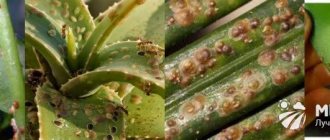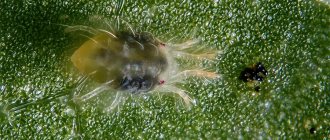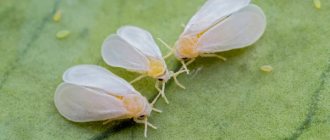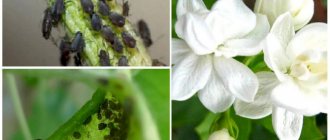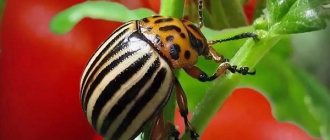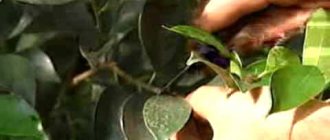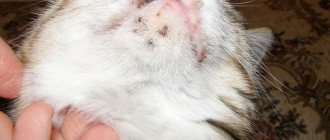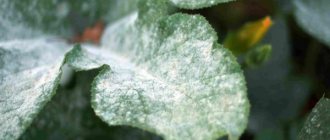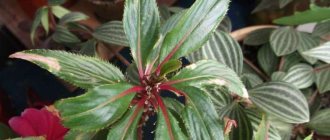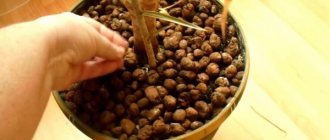Since pests spread very quickly at home, all crops need to be inspected periodically in order to detect the problem in time. Diseases of indoor flowers require immediate treatment, since in a confined space the disease spreads quickly and can affect all crops in the house. Diseases can be caused by viruses, fungi and bacteria, and if pests appear, they can always be removed manually and measures taken to prevent the spread of insects. Preventive measures include isolating the affected plant and monthly treating all potted crops with special solutions.
From the article you will learn which diseases and pests are most often found on indoor flowers and learn to recognize them by their characteristic symptoms. In addition, we will provide useful information on the effective treatment of diseases and the most popular methods of pest control.
- Causes
- Causes
- Causes
- Causes
- Causes
Types of diseases of indoor plants
Indoor flower crops are susceptible to various diseases. For example, a white velvety coating may appear on the leaves or buds. This is a disease called powdery mildew, which is caused by a special type of fungus. The development of the disease is promoted by stagnation of water, a sharp decrease in temperature and irregular watering. The affected leaves need to be removed, the temperature and watering regime adjusted, and the crop itself should be treated with a fungicide (three times with an interval of 10 days).
The most common diseases include (Figure 1):
- Mycosis (gray rot) causes the formation of mold, after which the leaves simply rot. The disease appears when there is an increased level of humidity, too dense housing and insufficient ventilation. You can fight mycosis with fungicides only if the lesions are small. But most often the flowerpot is simply thrown away.
- If the leaves are covered with black soot , which quickly forms a crust, this means that the crop is damaged by black. Plaque does not directly harm, but spoils its appearance and interferes with photosynthesis. There is no point in fighting plaque with fungicides. The only way to eliminate it is to regularly wipe the leaves or rinse them in the shower. You can use a weak alcohol solution or beer.
- Late blight is also caused by fungi. Stems and leaves become covered with purple-brown spots, wither and gradually die. The disease can be provoked by too intense watering or a dense substrate. It is useless to fight late blight, and the affected specimen is simply thrown away along with the substrate. To prevent the appearance of the disease, flowerpots should be planted only in a specially prepared soil mixture, and in winter the room should be regularly ventilated.
Sometimes nearby leaves begin to wilt and turn brown. This process is caused by a special fungal disease, which is practically useless to fight. The affected flower should be thrown away as quickly as possible so that the fungus does not spread to neighboring crops.
Figure 1. Common diseases of indoor plants: 1 - powdery mildew, 2 - gray rot, 3 - black soot, 4 - late blight
Another sign of the disease is cinnamon or black spots on the leaves. It could be scab, cercospora blight or anthracnose. As is correct, regular spraying with fungicides helps, but if the leaf tissue begins to die, all damaged parts will have to be removed. Bordeaux mixture is considered the most effective remedy, which can be used not only for medicinal but also for preventive purposes.
Viral
Some crops are affected by viruses. Leaves begin to discolor or become misshapen. There is no effective method of control, so the diseased flower must be destroyed so that it does not infect other crops.
The most common viral diseases of indoor flowers include (Figure 2):
- Mosaic - leaves are covered with spots of different colors and shapes, which form a bizarre pattern. In this case, the mosaic does not cause serious harm, but it can spoil the appearance.
- Jaundice is a dangerous viral disease, as the affected crop quickly begins to wither, wither, stop growing and die. Treatment for jaundice has not yet been developed, so it is better to destroy the infected flower immediately.
Figure 2. Signs of viral damage
There are also varieties that are not susceptible to diseases at all. These include aspidistra, caladium, cyperus and many others. Examples of such crops are shown in Figure 3.
From the video you will learn how to properly deal with the most common diseases of indoor plants.
Bacterial
Bacterial diseases also pose a danger to home crops, as they not only slow down the growth of the plant, but also spoil its appearance. There are several types of diseases in this group.
Figure 3. Examples of disease-resistant crops: 1 - aspidistra, 2 - caladium, 3 - cyperus
The most common bacterial diseases are considered (Figure 4):
- Rot especially often affects varieties with fleshy leaves and stems. Provoking factors may be high humidity and excessive use of nitrogenous fertilizers.
- Wilting first affects the stems, gradually switching to the leaves.
- Spotting is manifested by the formation of dead areas on the leaves. Unlike fungal spots, bacterial spots have clear contours.
- Bacterial cancer provokes the formation of growths on roots and young shoots. As the disease spreads, the culture weakens and gradually dies.
Figure 4. Bacterial diseases of indoor flowers: 1 - rot, 2 - wilting, 3 - spotting, 4 - bacterial cancer
To combat bacterial diseases, there is no point in using chemicals, since they are not sufficiently effective. In case of severe damage, the plant is destroyed along with the soil and pot, but it is much more effective to take preventive measures and use fertilizers sparingly.
Powdery mildew on indoor plants: treatment
Powdery mildew can appear not only on open ground crops, but also on indoor plants. The causative agent of the disease is a special type of fungus that forms mycelium on leaves and stems.
Powdery mildew requires treatment after the first symptoms are detected, because the uncontrolled development of the fungus will lead to the fact that the crop will begin to weaken, slow down growth and may even die.
Causes
The causes of powdery mildew are very diverse. But most often this disease is caused by high humidity and temperature. In addition, the disease can be caused by improper care and exposure to pests. For example, if a plant is weakened after an attack by insects or mites, it becomes more susceptible to fungi.
Figure 5. Symptoms of powdery mildew on indoor flowers
The onset of the disease can be triggered by excessive fertilizing with nitrogenous fertilizers and low calcium content in the soil. In addition, the disease can also appear if drops of water remain on the leaves and stems for a long time after watering.
Symptoms
A characteristic symptom of powdery mildew is the formation of a dense white coating on the leaves and stems. This plaque contains fungal spores, but is easily cleaned off by hand (Figure 5).
Enhytrea
These insects, which look like small white worms (about 1 cm long), can be seen if you remove the plant from the pot. Enchytraeas are an excellent food for aquarium fish; they are generally considered harmless for plants, since they feed primarily on dead plant tissues. Enchytraea is a signal that a swamp has been created in the pot, the plant is waterlogged, and the roots rot from excessive watering - and the enchytraea eats them up. As a result, the plant is suppressed and stunted in growth, dying rather from overwatering than from white worms.
Control measures. If these pests are detected, you need to wash the roots from the old soil and plant the plant in fresh soil. If the plant cannot be replanted for some reason, then you need to water the soil with an insecticide solution. And carefully loosen the soil. If such white worms appear in flower pots, think that perhaps you are watering the flowers too much! Enchytraea is usually introduced with organic fertilizers or garden soil. But if watering is not too frequent, the worms dry out and die.
Houseplant diseases: sticky leaves
Under normal conditions, the leaves of indoor plants are smooth and dry. But if they are covered with a sticky coating, this indicates a pathology that requires immediate treatment (Figure 6).
Among all the diseases of domestic flowers, sticky leaves cause the gardener the most trouble, because this coating not only spoils the appearance of the flower, but also worsens its general condition. Let's try to figure out what causes a sticky coating and how to properly eliminate it.
Causes
The main reason for the appearance of sticky plaque is the influence of pests, which may not be visible to the naked eye, but at the same time they feed on the juices of the flower and weaken it.
Sticky leaves appear if scale insects or false scale insects, aphids, mites or whiteflies have settled on the crop. All these insects cover the leaves with their waste products, which form an unpleasant sticky coating.
Symptoms
It is very easy to determine the presence of sticky plaque - just touch the leaves. Do not underestimate the problem, because a plant whose leaves are covered with sticky waste products of pests quickly loses moisture and nutrients and becomes more susceptible to fungal and viral diseases. In addition, sticky substances clog the pores in the leaves, and the flower cannot breathe normally.
Figure 6. Sticky leaves of indoor flowers and methods for eliminating pathology
If measures to eliminate plaque are not taken in time, the flower will quickly wither, stop growing, and may even die if this flower has previously suffered a disease or transplantation.
Treatment
Since the main factor causing the formation of plaque on leaves is pests, it is necessary to take measures to combat insects. First, you need to treat the flower with insecticides or acaricides (if mites were found on the stems). The culture itself must be thoroughly washed with a solution of laundry soap, carefully but carefully washing off plaque from each leaf.
If the plaque has already spread throughout the culture, folk methods of control will not be enough. In this case, it is better to rinse the leaves with clean water and treat the crop with Fitoverm, dissolving the contents of one ampoule in water.
Houseplant diseases: dry leaf tips
If the tips of the leaves of the flowerpot begin to dry, most likely the air in the room is too dry or the crop is not properly cared for (Figure 7).
In fact, there are quite a few reasons for the appearance of dry tips on leaves, so you need to objectively evaluate all the factors and take appropriate measures to eliminate the pathology.
Causes
As mentioned above, dry leaf tips appear when there is low humidity in the room. But this is far from the only reason.
Among the factors that can cause drying of leaves at the tips are::
- Watering with hard tap water;
- Violation of the watering schedule: excessive moisture or drying out of the earthen clod;
- Increased or decreased content of fertilizers in the soil;
- Increased room temperature or exposure to direct sunlight;
- A tight pot in which the roots have completely encircled the soil and formed a dense earthen ball.
In addition, dry leaf tips can appear when exposed to pests. To eliminate the problem, you need to assess the degree of influence of all factors that could lead to pathology and take appropriate measures to eliminate them.
Symptoms
At the initial stage, only a small part of the tip of the leaf begins to dry out. It is at this stage that you need to inspect the plant for the presence of pests and review the crop care schedule.
Figure 7. Diseases of indoor plants: dry leaf tips
For example, if aphids appear on a flower, you may notice colonies of small insects on the stems or lower parts of the leaves. If mites have settled on a flower, a small cobweb will appear between the nodes, and when scale insects attack the leaves, you can notice small, dense and motionless insects.
Treatment
If the tips of the leaves begin to dry out under the influence of pests, you need to treat them with chemicals, and after a few days repeat the procedure to eliminate the young individuals that have hatched from the larvae.
But much more often, the tips of the leaves dry out due to improper care. First of all, you need to improve the quality of water for irrigation. For this purpose, it is better to use melt or rain water, but if you do not have such an opportunity, you can use regular tap water. In addition, you need to increase the humidity in the room by spraying the leaves with boiled water at room temperature or installing a stationary humidifier nearby.
Scale insects on indoor plants: treatment
It is quite easy to detect pest insects by examining the surface of the stems and leaves. Below is information about the most common insects that can damage or completely destroy an indoor flower.
- Aphid
Most often appears in spring or late winter. Externally, insects are very small and can be black, gray or green. Aphids feed on the sap of the plant and secrete a sticky, poisonous sap. As a rule, the pest is located on young shoots and buds. The risk of damage is especially high if the flower is taken out into the garden in the summer (Figure 8).
Figure 8. Examples of plants affected by aphids
To save the flower, immediately remove and burn the affected parts. You can also try to wash away the insects with strong water pressure. After this, they are treated with special insecticides for indoor crops. The main victims of aphids are roses and chrysanthemums, but they are not afraid of crops with dense and fleshy leaves.
- Ticks
The main sign of damage is the cobwebs that appear between the leaves and stems. Since the size of individual specimens is less than 1 mm, it is almost impossible to see them. But with a large concentration of insects, the leaves gradually lose color and become gray. Ticks reproduce especially intensively in dry, hot weather (Figure 9).
Figure 9. Damage to indoor plants by mites
For prevention, a high level of humidity is maintained, so flower leaves should be sprayed with clean water as often as possible. But if ticks do appear, special means - acaricides - are used to eliminate them.
- Whiteflies
This is a separate subspecies of aphids. The insects reproduce very quickly, and the adults take off in a flock as soon as you touch the leaves. They feed on the juices of stems and leaves and quickly lead to their death. Therefore, as soon as you find whiteflies, treat the flower with a special insecticide. The procedure must be repeated every 8 days, since the drug only affects adults.
- Weevils
The insects are up to 2 cm long. They eat leaves and young stems. The larvae resemble small worms and feed on roots. For treatment, insecticides are used, which are sprayed onto the plants four times with a one-week break. For prevention, you need to buy only specialized industrially produced substrates that are guaranteed to be free of pests or their larvae.
Houseplants may also be exposed to other pests (Figure 10):
- Cicadas: These are small insects that jump when you touch the leaves. They feed on juices. To combat it, simply remove damaged leaves and stems and rinse the flower well in the shower. As a rule, this is sufficient and no special chemical treatment is required.
- Caterpillars: rarely appear on house flowers, but the possibility of damage still exists. They are removed manually and regular preventative spraying is carried out.
- Scale insects: feed mainly on the sap of flowerpots with dense, fleshy leaves. Insects must be removed manually by washing the leaves with an aqueous-alcohol solution.
- Red spider mite: quite common in city apartments. It is difficult to notice the insect, but its presence can be determined by spots on the leaves in places where the insects feed. In addition, ticks leave a thin web. To combat ticks, you need to increase air humidity and constantly spray the outside and inside of the leaves.
- Woodlice damage roots by eating them. However, they do not have time to cause serious damage, since pests are easy to detect and eliminate manually.
Figure 10. Common pests of indoor plants: 1 - whiteflies, 2 - caterpillars, 3 - scale insects.
Also, crops grown in pots can be damaged by millipedes and leaf miner flies. To combat centipedes, it is enough to transplant. It is easy to determine the presence of leaf miner flies by looking at the passages in the leaves that the insect larvae gnaw through. Since indoor plants are rarely subjected to massive attacks, it is sufficient to carry out preventive monthly spraying with insecticides.
Note: Dense brown spots can often be seen on the back of the leaves. These are the so-called scale insects that drink plant sap. To combat them, simply carefully scrape off the pests and treat the damaged leaves with a weak soap or beer solution. If there are a lot of scale insects, repeat the treatment after 10-15 minutes.
When using untreated garden soil in a pot, earthworms and podars (small jumping insects that do not cause serious harm, but spoil the aesthetic appearance of the plant) may appear. They can only be combated by transplanting the crop into a special industrially produced substrate. You will learn more useful information about pest control from the video.
Scale insects are one of the most common pests of indoor plants. These insects pose a great danger, since they feed on plant juices, and it is difficult to notice scale insects at the initial stage of infection.
Causes
The reasons that provoke the invasion of scale insects are very diverse. As a rule, they appear on home flowers due to improper care, which weakens the culture.
In addition, pests can settle on flowers weakened after illness. Most often, scale insects are carried with soil or water, but in some cases they can be spread by humans themselves if contaminated equipment was used for caring for and replanting plants.
Symptoms
The presence of scale insects can be determined by their characteristic features (Figure 11). The first of these is the appearance of dense brown or light growths on the leaves. Outwardly, they resemble scales and are difficult to separate from the plant.
Note: This is what adult pests look like, but it is impossible to detect the larvae, since they are not visible to the naked eye.
In addition, a plant affected by scale insects gradually slows down its growth and weakens, its leaves become covered with a sticky coating (the result of the vital activity of insects), and brown spots appear in places of severe damage. Gradually, these spots increase in size and, if pest control measures are not taken, the plant dies.
Figure 11. Scale insects on indoor flowers: symptoms of damage
Treating scale insects is not an easy task, since the pest is protected from the outside by a dense shield that does not allow chemical control agents to enter. At the initial stage of the lesion, you can try to remove the scale insects manually, using an old toothbrush dipped in an alcohol or soap solution. In case of severe damage, you need to carry out several stages of spraying with Actellik (1 ampoule per liter of water) or Fosbecid (20 ml per 10 liters of water). The latter drug is toxic, so treatment can only be carried out outdoors.
Insecticides for caterpillar control
Insecticides can be contact (they protect only the treated parts of plants, act quickly, but, as a rule, they are also quickly washed off by rain), intestinal (enter the insect’s body with food and thus destroy the pest), systemic (affect insects in various ways).
The following drugs can be used to control caterpillars:
Bitoxibacillin is a biological product based on bacteria. Effective against caterpillars of vegetable, fruit, flower and ornamental crops. In summer, with a high density of pests, to achieve the desired result, treatments should be frequent and regular (with an interval of 7-8 days).
Lepidocide is another biological product designed to combat caterpillars in the garden, vegetable garden and flower garden. During the heavy rainy season, regular treatment is required (every 7-8 days).
Monsoon is a drug with a wide spectrum of effects. Resistant to temperature fluctuations. The effect of use lasts about 15-30 days.
Iskra M – cannot be used near water sources. It acts quickly and is effective within two weeks.
Inta-Vir is a broad-spectrum drug. Dangerous for beneficial insects (therefore, plants should not be sprayed during the flowering period) and aquatic inhabitants.
Senpai - affects insects by contact. Valid for 2 weeks. Dangerous for bees.
All insecticides must be used with extreme caution, in no case exceeding dosages
Diseases of indoor flowers: white plaque
A white coating that suddenly appears on the leaves or buds of indoor plants indicates that the flower is infected with powdery mildew (Figure 12).
This is a fungal disease, and the white coating is mycelium, which contains fungal spores. The danger of the disease is that it spreads quickly, so when the first symptoms are detected, it is necessary to immediately take therapeutic measures.
Causes
There are not very many reasons that can cause powdery mildew infection. Firstly, the disease is provoked by improper and irregular watering, when water accumulates at the roots or remains on the leaves.
In addition, the cause of the development of powdery mildew can be increased room temperature, combined with high humidity. This happens especially often in summer, but signs of powdery mildew can also appear in winter if the plant suffers from sudden changes in temperature.
Symptoms
A characteristic symptom of powdery mildew is a white coating that first covers individual parts of the plant. But without treatment, it will quickly spread throughout the culture.
Figure 12. White plaque on home flowers and its treatment
Powdery mildew not only spoils the appearance of the plant, but also weakens it, since the fungus slows down the absorption of water and nutrients into the crop tissue. If the fungus has spread strongly, brown spots will begin to form in place of the white coating, and the plant may die.
Treatment
Treatment for powdery mildew depends on the stage of the lesion. If the disease has just begun, it will be enough to remove and burn the damaged parts, and spray the plant itself with any anti-fungal drug (for prevention).
In case of severe damage, use a solution of fungicides. The culture is sprayed up to three times with an interval of 10 days to completely destroy the fungus.
What caterpillars can be found in the garden?
There are many types of caterpillars that can ruin the life of a gardener. The most common species in the garden are hawthorns. Their clutches can usually be found on tree leaves entangled in cobwebs. Neighboring them are goldentails, which settle on small branches, also enveloping them in a “shawl” of cobwebs.
Leaf rollers are extremely dangerous, which, despite their small size, can quickly destroy buds, leaves and flowers. A sign that these particular caterpillars have chosen your site are the leaves of plants twisted into a tube, inside of which there is the same cobweb. Several generations of leaf rollers are born in one season, so it is necessary to combat this pest very quickly. And if you notice a furry caterpillar or a cluster of eggs covered with fine hairs, most likely a gypsy moth has decided to breed in your area. It can easily and quickly capture the entire area, as it moves from place to place along with the wind.
Prevention of diseases and pests of indoor plants
Most often, indoor plants suffer from diseases and pests due to improper care. Much less often, pathogens and pest larvae penetrate from the outside, for example, when using ordinary garden soil for growing flowers.
To keep your plants strong and healthy, you need to follow simple preventive measures. Firstly, moderately fertilize and water the plants, avoiding excessive drying out or waterlogging of the earthen clod. Secondly, each species needs to be provided with optimal growing conditions: humidity levels, lighting and temperature. In addition, it is necessary to regularly prune and replant indoor flowers to ensure they have enough space to grow.
Centipedes
These whitish or dark brown insects, similar to a caterpillar with numerous legs, can harm indoor plants placed in the garden for the summer. They end up in flower pots with soil from the garden, sometimes with purchased soil. Millipedes eat the root areas of plants and lower leaves, as evidenced by eaten away areas in healthy plant tissues. Some types of centipedes are harmless, but unpleasant, even disgusting - they do not harm plants, but I would like to get rid of them.
Control measures. Drying the surface of the soil in the pot, sprinkling the soil with dry sand or ash. Centipedes hide in dark and damp places, so you can detect and collect pests by placing a wooden plank, a small piece of linoleum, a circle of cucumber or zucchini on the soil near the plant. Centipedes will crawl under such a trap, from where you can catch them with your hands and throw them away.
